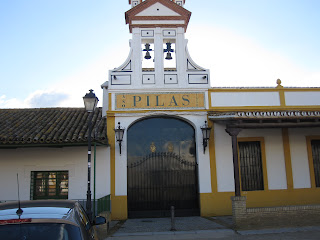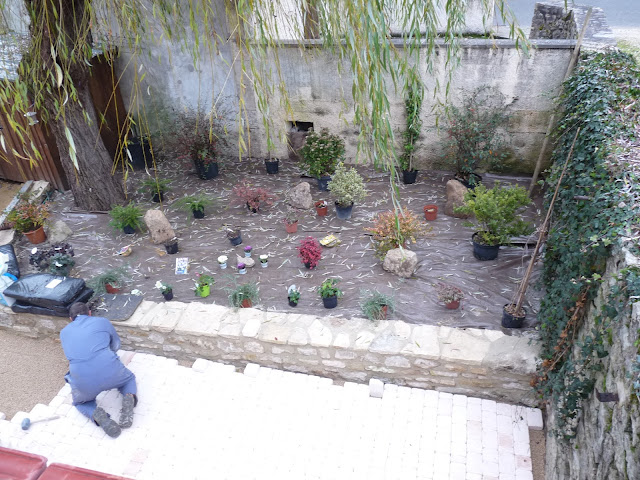 Behind the house there's the old railroad bed, now a walking path and also a widening of this path where there used to be poubelles, the ubiquitous waste and recycling bins. Already parked there for the weekend was a jolly green giant of what I call a "Lull", a construction tractor for lifting roofers and materials for the Glancy's new roof next door. So it was amazing when the fire department arrived this morning--Sunday!-- and parked a rescue truck and captain's car alongside.
Behind the house there's the old railroad bed, now a walking path and also a widening of this path where there used to be poubelles, the ubiquitous waste and recycling bins. Already parked there for the weekend was a jolly green giant of what I call a "Lull", a construction tractor for lifting roofers and materials for the Glancy's new roof next door. So it was amazing when the fire department arrived this morning--Sunday!-- and parked a rescue truck and captain's car alongside.I looked around among the guys (and one woman) and eventually caught sight of Pascal Martina the
 |
| Pascal Martina |
The helmets are pretty amazing. If I joined it would be to wear a helmet like this once in a while. I find it a little odd that the rest of the uniform is so totally functional and non-glamorous.
 |
| This is how to hold your lips when pronouncing the "u" in super |
 |
| I didn't see the pretty girl wearing her helmet |
Happily they weren't in sapeur mode but seemed to be just practicing using harnesses and climbing equipment. It took around a quarter hour to attach what appeared to be a hoisting rope about 16 feet along the bridge. The sign on their truck read, "Assistance to victims" but nothing about being a "fast squad" as in Vermont. (I used to get a kick out of the volunteers from Fairlee who had decals on their pickup trucks that actually read, "Fairlee Fast Squad")
 It seems to me that Andy Siegler was right, that the French "do systems really well," The two teams were obviously well prepared and each had an older and wiser person in charge, Pascal on the downstream side.
It seems to me that Andy Siegler was right, that the French "do systems really well," The two teams were obviously well prepared and each had an older and wiser person in charge, Pascal on the downstream side.One of the last times I had the Kangoo in his shop, Pascal got to talking about fire departments. This Castlefranc department had recently come door to door with calendars and the contribution that they were too discrete to actually come right out and ask for. I told Pascal he looked great on the calendar but should have been wearing a bikini with his shiny helmet. He was very proud of their training. He said that if there were an emergency at local chemical factory, they had strict instructions to dial the red phone at the prefecture in Cahors. He said that when there is an accident on a divided highway in France, two crews are sent out: one directs traffic around the accident and the other deals with the inevitable accident in the other directons that results from rubbernecking. He said the deaths and injuries among the firefighters at 9-11 resulted from a macho cowboy mentality that never would have happened in France.



























